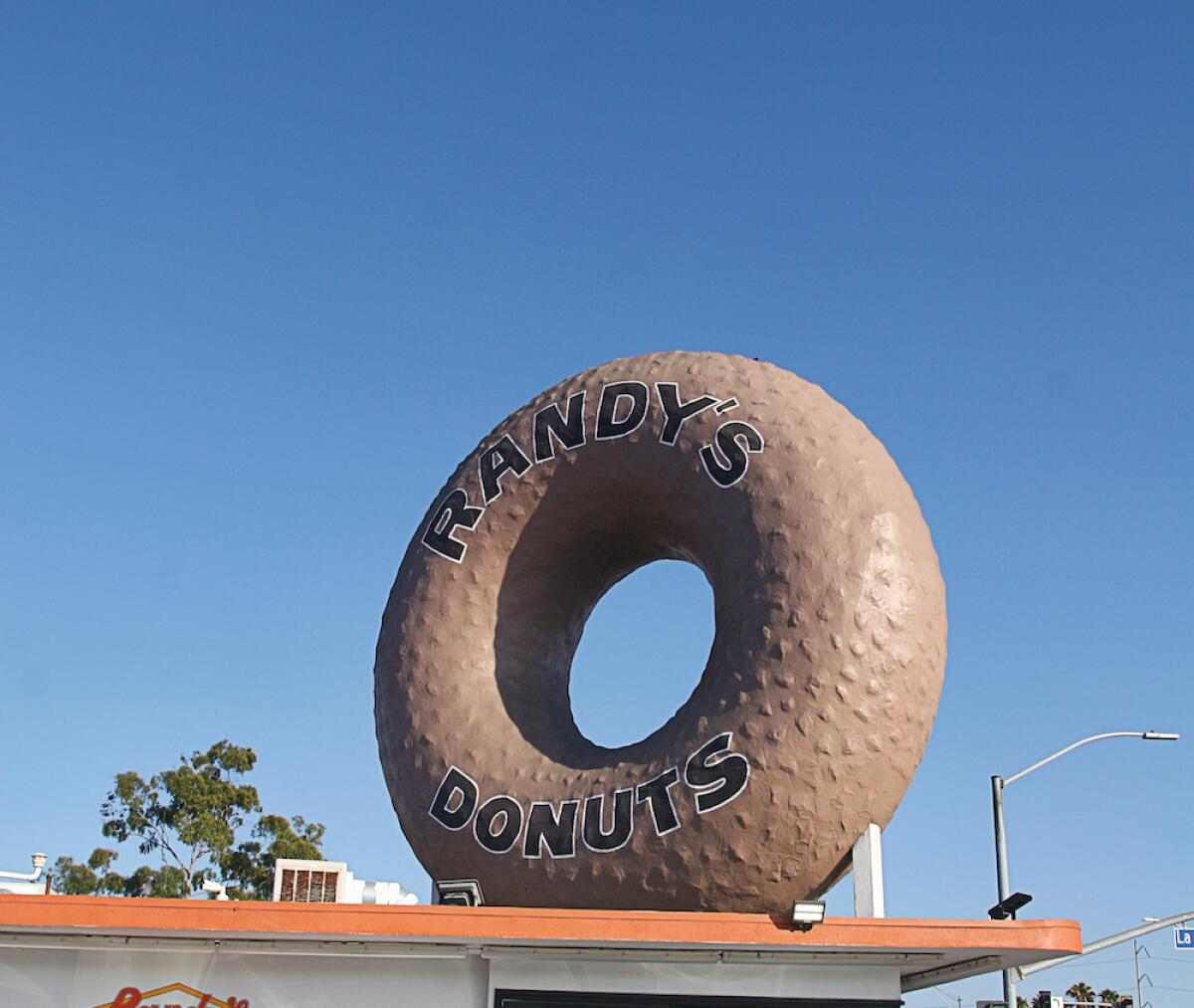Randy’s Donuts: The World-Famous Marketing Stunt is a Giant Sign of Yesteryear

- Share via
Driving on the 405 to the office, or the airport, or a concert, and directly off the La Cienega exit, you see it: the giant Randy’s doughnut, standing more than two stories higher than anything else around it. Whether you call it a sculpture or a sign, the big doughnut has been Inglewood’s beloved rooftop icon since 1953, and an uncompromising reminder that anytime you crave one of those tasty fried cakes, they are available right here, at 805 W. Manchester Boulevard 24/7.
The big round brown sculpture is a 32-foot steel wheel with a hole in the middle and a donut-textured brown-painted skin. It was not L.A. County’s first giant rooftop doughnut, but it’s absolutely the most famous. It has had supporting roles in numerous films and TV shows and has drawn photographers and architecture historians the world over to marvel at its bold presence.
The shop has appeared in films including “Get Shorty,” “Mars Attacks” and “Earth Girls are Easy.” Robert Downey, Jr., in character, had a snack while sitting inside the doughnut hole in “Iron Man 2.”
The doughnut had a moving role in the disaster film, “2012.” As John Cusack charges his car through Los Angeles while the entire city is collapsing behind and around him, the Randy’s Donuts sign tumbles off the roof and rolls down the sinking street toward oblivion.
Its TV credits include “Arrested Development,” “Entourage” and “The Simpsons.” The shop also was seen in music videos by the Red Hot Chili Peppers, Justin Timberlake and, of course, Randy Newman’s “I Love L.A.” Why has it drawn so much attention? Former Inglewood Public Arts Commissioner Anne Cheek La Rose said she thought the giant doughnut’s wide-ranging fame could be partially credited to its location next to one of the most-travelled freeways in California.
“From the 405 going north, or going south, it doesn’t matter which, you can see the doughnut,” she said in a podcast for the city’s website. “Visibility helps a lot.” “It’s a neat place, and the doughnuts are pretty good, too,” La Rose said.
“Baking” Up An Idea
Back in the late 1940s, a doughnut machine salesman named Russell C. Wendell decided to cash in on L.A.’s emerging car culture by launching a chain of shops he named the Big Donut Drive-Ins. The first of 10 shops opened in 1951 in Westmont, an unincorporated community just east of Inglewood. The second store, now Randy’s Donuts, was next, in 1953.
The architect Wendell hired was Harry J. Goodwin, who ultimately designed the shops as modest Midcentury Modern boxes, each with a huge, faux doughnut on the roof. They called in a local noted structural engineer, Richard Bradshaw, to figure out how to pull it off. He used rolled steel bars to create the round shape and covered them with a concrete blend of sand, cement, and water that was applied through a high-pressure hose. The doughnut sculptures for nine of the original stores measured 32 feet across and weighed 15,000 pounds. All were painted a crisp golden brown.
The big doughnuts are perched on the shop roofs, secured by steel supports. And this is where a little controversy comes up among architectural historians. Most published references say that Randy’s Donuts is an example of Programmatic architecture, but a few observers have pointed out that Programmatic architecture describes buildings with unusual shapes that mimic the products offered for sale. The giant doughnut, they claim, is technically a novelty sign, no different from life-sized cow statues on top of drive-in dairies that were ubiquitous in 1950s Los Angeles.
But the size and weight, and the fact that it is large enough to be seen from aircraft coming in for a landing at LAX, make it quite an impressive sign. So what is the fuss about?
(An added note: Bradshaw later worked with William Pereira to design and build the space-age theme building at LAX in the late 1950s, among other elegantly modern Los Angeles landmarks. He worked with many well-known architects and was one of the most sought-after modern architectural engineers from the 1950s through the 1980s.)

Randy’s Renewal
Wendell, inspired by the success of drive-through hamburger joints, eventually sold all the individual doughnut stores during the 1970s and focused on opening a chain aof Pup ‘N Taco hot dog and taco drive-through restaurants. In addition to Randy’s, three of the original doughnut drive-ins are still open, although the Bellflower store turned the doughnut into a bagel. Inglewood’s Big Donut Drive-In has had several owners, and the name was changed to Randy’s Donuts in 1976. Brothers Ron and Larry Weintraub bought it in 1978, operating it as a single store for 37 years. They decided to retire and sold the store to Mark Kelegian, an attorney and entrepreneur, in 2015.
Today’s Randy’s Donuts has an active marketing campaign: the website offers logo t-shirts, hats, and bumper stickers - “Don’t accept imitations!” it warns. Franchises are available in “select locations.” The website lists several new shops, most in Los Angeles County, one in Bakersfield and four in South Korea - maybe not so surprising as Kelegian told the Los Angeles Business Journal in 2017 that he planned to expand the brand internationally.
Photos of the newer shops show doughnut signs that are smaller than the originals, and most are affixed to walls or are free-standing on the ground. Will any of the new stores ever have a giant donut sign on the roof? Not likely, Kelegian told the Journal, because presently most cities have rules on size, height, and appearance of any signage.
“Every city employee will tell you today that you’d never get that built now,” he said.